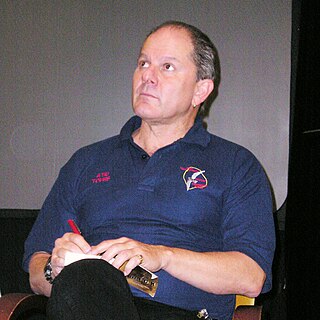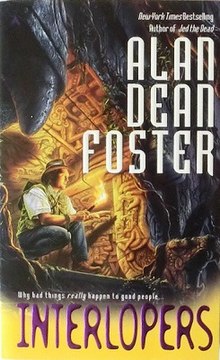
Ray Douglas Bradbury was an American author and screenwriter. He worked in a variety of genres, including fantasy, science fiction, horror, and mystery fiction.

The Chronicles of Narnia is a series of fantasy novels by British author C. S. Lewis. Written by Lewis, illustrated by Pauline Baynes, and originally published in London between 1950 and 1956, The Chronicles of Narnia has been adapted for radio, television, the stage, and film. The series is set in the fictional realm of Narnia, a fantasy world of magic, mythical beasts, and talking animals. It narrates the adventures of various children who play central roles in the unfolding history of the Narnian world. Except in The Horse and His Boy, the protagonists are all children from the real world who are magically transported to Narnia, where they are sometimes called upon by the lion Aslan to protect Narnia from evil. The books span the entire history of Narnia, from its creation in The Magician's Nephew to its eventual destruction in The Last Battle.

The Martian Chronicles is a 1950 science fiction short story fixup by American writer Ray Bradbury, which chronicles the colonization of Mars by humans fleeing from a troubled and eventually atomically devastated Earth, and the conflict between aboriginal Martians and the new colonists. The book lies somewhere in between a short story collection and an episodic novel, containing stories originally published in the late 1940s in science fiction magazines. The stories were loosely woven together with a series of short, interstitial vignettes for publication.

The Thing from Another World, sometimes referred to as just The Thing, is a 1951 American black-and-white science fiction-horror film, directed by Christian Nyby, produced by Edward Lasker for Howard Hawks' Winchester Pictures Corporation, and released by RKO Pictures. The film stars Margaret Sheridan, Kenneth Tobey, Robert Cornthwaite, and Douglas Spencer. James Arness plays The Thing, but he is difficult to recognize in costume and makeup due to both low lighting and other effects used to obscure his features. The Thing from Another World is based on the 1938 novella Who Goes There? by John W. Campbell.

The Dig is a point-and-click adventure game developed by LucasArts and released in 1995 as a CD-ROM for PC and Macintosh computers. Like other LucasArts adventure games, it uses the SCUMM video game engine. It also features a full voice-acting cast, including notable voice actors Robert Patrick and Steve Blum, and a digital orchestral score. The game uses a combination of drawn two-dimensional artwork and limited, pre-rendered three-dimensional movies, with the latter created by Industrial Light & Magic.

Alan Dean Foster is an American writer of fantasy and science fiction, who has written several book series, more than 20 standalone novels and many novelizations of film scripts.

Underworld is a 1997 novel by the American writer Don DeLillo. The novel is centered on the efforts of Nick Shay, a waste management executive who grew up in the Bronx, to trace the history of the baseball struck in The Shot Heard 'Round the World, and encompasses numerous subplots drawn from American history in the second half of the twentieth century. Described as both postmodernist and a reaction to postmodernism, it examines themes of nuclear proliferation, waste, and the contribution of individual lives to the course of history.

Wilbur Addison Smith is a British novelist specialising in historical fiction about the international involvement in Southern Africa across four centuries, seen from the viewpoints of both black and white families.

Robert Paul "Tad" Williams is an American fantasy and science fiction writer. He is the author of the multivolume Memory, Sorrow, and Thorn series, Otherland series, and Shadowmarch series as well as the standalone novels Tailchaser's Song and The War of the Flowers. Most recently, Williams published The Bobby Dollar series. Cumulatively, over 17 million copies of Williams's works have been sold.

The Sword of Shannara is a 1977 epic fantasy novel by American writer Terry Brooks. It is the first book of the Original Shannara Trilogy, followed by The Elfstones of Shannara and The Wishsong of Shannara. Brooks was heavily influenced by J. R. R. Tolkien's The Lord of the Rings and began writing The Sword of Shannara in 1967. It took him seven years to complete, as he was writing the novel while attending law school. Ballantine Books used it to launch the company's new subsidiary Del Rey Books. Its success boosted the commercial expansion of the fantasy genre.

Halo: The Fall of Reach is a military science fiction novel by Eric Nylund, set in the Halo universe, and acts as a prequel to Halo: Combat Evolved, the first game in the series. The book was released in October 2001 and is the first Halo novel. It takes place in the 26th century across several planets and locations. The novel details the events which led up to the game and explains the origins of the SPARTAN II super soldiers, narrating the story of the series protagonist, the Master Chief.

Revelation Space is a 2000 science fiction novel by Welsh author Alastair Reynolds. It was the first novel set in Reynolds's eponymous universe. The novel reflects Reynolds's professional background: he has a PhD in astronomy and worked for many years for the European Space Agency. It was short listed for the 2000 BSFA and Arthur C. Clarke Awards.

Ninja Gaiden III: The Ancient Ship of Doom is a side-scrolling platforming video game developed and published by Tecmo. It was released in Japan on June 26, 1991 for the Famicom and in North America in August 1991 for the Nintendo Entertainment System (NES). The NES version was not released in Europe. It was later ported to the Atari Lynx by Atari and released in 1993 in North America and Europe, the European version retaining the North American Ninja Gaiden III title. It was also re-released as part of its Ninja Gaiden Trilogy Super NES compilation in 1995 in Japan and North America. Long after, it was released for the Virtual Console service in North America on February 18, 2008 for the Wii and in North America and Europe on November 28, 2013 and January 23, 2014 respectively for the Nintendo 3DS. It was designed by Masato Kato, who took over for Hideo Yoshizawa—designer of the first two games in the NES series.

The Book of the New Sun (1980–1983) is a series of four science fantasy novels, a tetralogy or single four-volume novel written by the American author Gene Wolfe. It inaugurated the so-called "Solar Cycle" that Wolfe continued by setting other works in the same universe.

Attack of the Crab Monsters is a 1957 independently made American black-and-white science fiction-horror film, produced and directed by Roger Corman, that stars Richard Garland, Pamela Duncan, and Russell Johnson. The film was distributed by Allied Artists as a double feature with another Corman feature, Not of This Earth.

A True Story is a novel written in the second century AD by Lucian of Samosata, a Greek-speaking author of Assyrian descent. The novel is a satire of outlandish tales which had been reported in ancient sources, particularly those which presented fantastic or mythical events as if they were true. It is Lucian's best-known work.

The Dying Earth is a collection of fantasy short fiction by American writer Jack Vance, published by Hillman in 1950. Vance returned to the setting in 1965 and thereafter, making it the first book in the Dying Earth series. It is retitled Mazirian the Magician in its Vance Integral Edition (2005), after the second of six collected stories.

The Stones of Nomuru is a science fiction novel by American writers L. Sprague de Camp and Catherine Crook de Camp, the tenth book in the former's Viagens Interplanetarias series and the first in its subseries of stories set on the fictional planet Kukulkan. It was first published as a trade paperback by Donning/Starblaze Editions in September 1988, and as a mass market paperback by Baen Books in May 1991. An E-book edition was published by Gollancz's SF Gateway imprint on September 29, 2011 as part of a general release of de Camp's works in electronic form. It has also been translated into Italian.

The Name of the Wind, also called The Kingkiller Chronicle: Day One, is a heroic fantasy novel written by American author Patrick Rothfuss. It is the first book in the ongoing fantasy trilogy The Kingkiller Chronicle, followed by The Wise Man's Fear. It was published on March 27, 2007 by DAW Books.

The Ogre's Wife: Fairy Tales for Grownups is a collection of fantasy short stories by American writer Richard Parks. It was first published in trade paperback by Obscura Press in August 2002. A Kindle edition was issued in 2011. The collection was nominated for the 2003 World Fantasy Award for Best Collection; its title story won the SF Age Reader's Poll for short story in 1995.




















